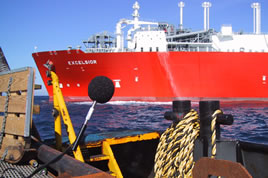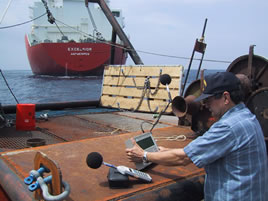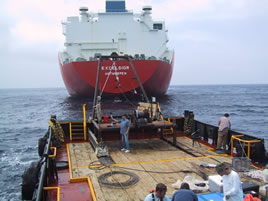Specialty
Noise / Vibration
SECTOR
Energy / Power
TYPE
Permitting / Compliance
CLIENTELE
Private Sector
TIMESPAN
2005-2006LOCATION
Cape Ann, MA
Project Number:
2546Northeast Gateway Project
SERVICE:
Noise Analysis for Deepwater LNG Port
DESCRIPTION:
The Northeast Gateway LNG Project is the first deep-water offshore LNG port (DWP) on the east coast, and is proposed for a site 12 miles off the coast of Cape Ann, Massachusetts. Specially-designed LNG tankers, Energy Bridge Regasification Vessels (EBRV), would dock at this port; LNG cargo would be vaporized on-board and then piped through a flexible riser to the pipeline end manifold (PLEM) on the sea floor that connects to the Hubline pipeline. In support of the project permitting efforts, Tech Environmental engineers collected sound level measurements of the underwater and the in-air sound generated by the specially constructed EBRV during LNG regasification, and the offloading operations that are located 117 miles offshore in the Gulf of Mexico at an existing DWP.
The purpose of the survey and analysis was to characterize the source data to be used in the in-air and underwater acoustic modeling and impact assessment. The Tech Environmental hydrophone system allowed for the measurement and analysis of sound energy encompassing the entire spectrum of audibility for both area marine mammals and fish populations. The generation, propagation and reception of underwater sound were calculated using a proprietary computer model that was developed specifically for the Cape Ann site. The measurement data and subsequent modeling were used to evaluate the potential for impact on marine animal life within the project area (underwater noise), as well as on the nearest populated areas onshore and recreational watercraft operating in the area (in-air noise). Tech Environmental wrote the noise sections for the permitting documents, including the federal Environmental Report.
Key Points
- The first deepwater LNG port project in the Eastern U.S. required marine acoustic data to complete the permitting process.
- Tech Environmental engineers collected sound level measurements at a similar port in the Gulf of Mexico and analyzed the data to demonstrate compliance.



